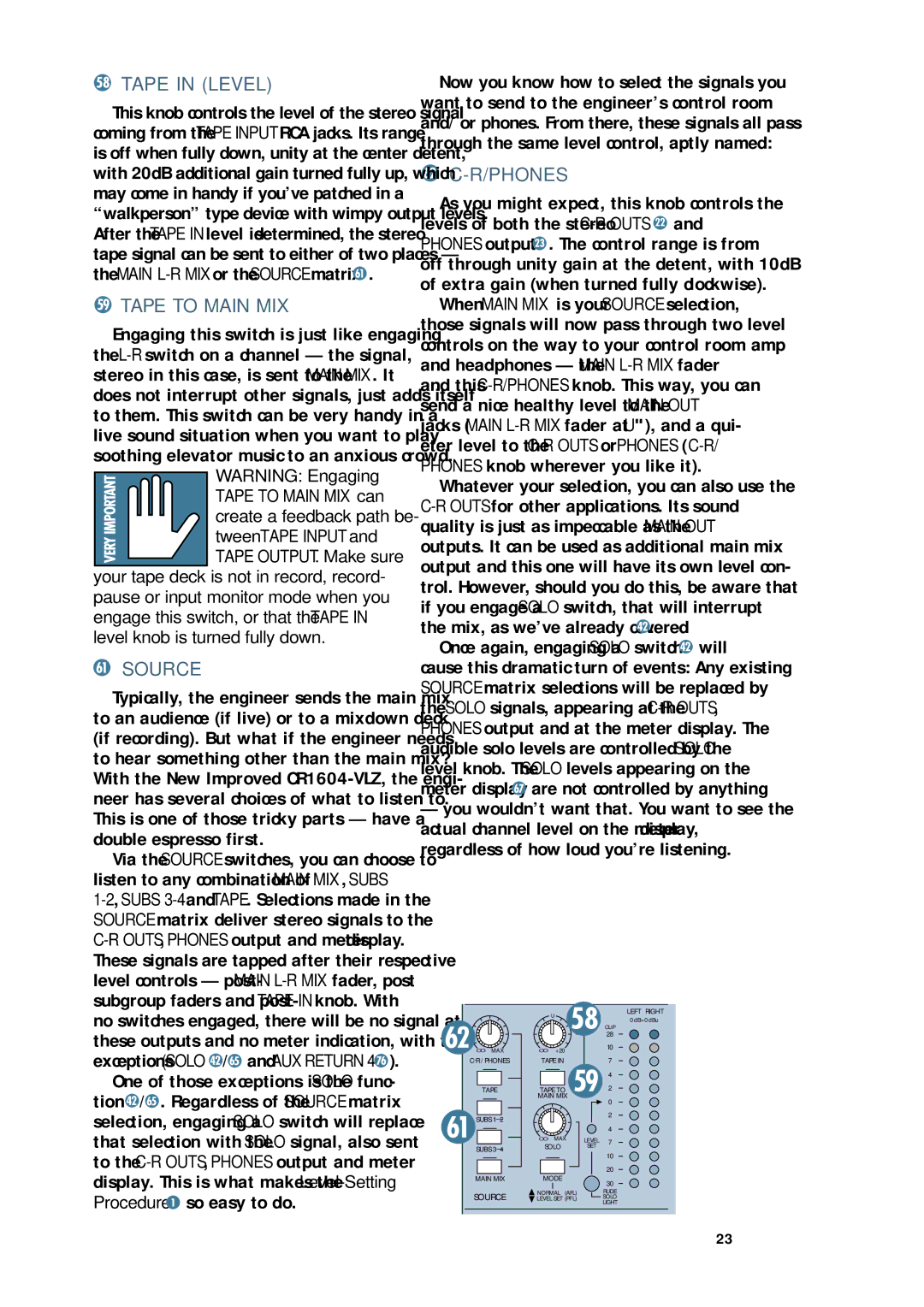
TAPE IN (LEVEL)
This knob controls the level of the stereo signal coming from the TAPE INPUT RCA jacks. Its range is off when fully down, unity at the center detent, with 20dB additional gain turned fully up, which may come in handy if you’ve patched in a “walkperson” type device with wimpy output levels. After the TAPE IN level is determined, the stereo tape signal can be sent to either of two places — the MAIN ![]() .
.
TAPE TO MAIN MIX
Engaging this switch is just like engaging the
![]() WARNING: Engaging
WARNING: Engaging
TAPE TO MAIN MIX can
create a feedback path be-
tween TAPE INPUT and
![]() TAPE OUTPUT. Make sure your tape deck is not in record, record- pause or input monitor mode when you engage this switch, or that the TAPE IN level knob is turned fully down.
TAPE OUTPUT. Make sure your tape deck is not in record, record- pause or input monitor mode when you engage this switch, or that the TAPE IN level knob is turned fully down.
SOURCE
Typically, the engineer sends the main mix to an audience (if live) or to a mixdown deck (if recording). But what if the engineer needs to hear something other than the main mix?
With the New Improved
Via the SOURCE switches, you can choose to listen to any combination of MAIN MIX, SUBS
Now you know how to select the signals you want to send to the engineer’s control room and/or phones. From there, these signals all pass through the same level control, aptly named:
C-R/PHONES
As you might expect, this knob controls the levels of both the stereo ![]() and PHONES output
and PHONES output ![]() . The control range is from off through unity gain at the detent, with 10dB of extra gain (when turned fully clockwise).
. The control range is from off through unity gain at the detent, with 10dB of extra gain (when turned fully clockwise).
When MAIN MIX is your SOURCE selection, those signals will now pass through two level controls on the way to your control room amp and headphones — the MAIN
Whatever your selection, you can also use the ![]() .
.
Once again, engaging a SOLO switch ![]() will cause this dramatic turn of events: Any existing SOURCE matrix selections will be replaced by the SOLO signals, appearing at the
will cause this dramatic turn of events: Any existing SOURCE matrix selections will be replaced by the SOLO signals, appearing at the ![]() are not controlled by anything
are not controlled by anything
—you wouldn’t want that. You want to see the actual channel level on the meter display, regardless of how loud you’re listening.
![]() /
/![]() and AUX RETURN 4
and AUX RETURN 4 ![]() ).
).
One of those exceptions is the SOLO func- tion ![]() /
/![]() . Regardless of the SOURCE matrix selection, engaging a SOLO switch will replace that selection with the SOLO signal, also sent to the
. Regardless of the SOURCE matrix selection, engaging a SOLO switch will replace that selection with the SOLO signal, also sent to the ![]() so easy to do.
so easy to do.
OO | MAX |
TAPE
SUBS
SUBS
MAIN MIX
SOURCE
U |
|
|
|
| CLIP |
|
| 28 |
OO +20 |
| 10 |
|
| |
TAPE IN |
| 7 |
|
| 4 |
TAPE TO |
| 2 |
MAIN MIX |
| 0 |
|
| |
|
| 2 |
|
| 4 |
OO MAX | LEVEL | 7 |
SOLO | SET |
|
|
| 10 |
|
| 20 |
MODE |
| 30 |
|
|
NORMAL (AFL) | RUDE |
LEVEL SET (PFL) | SOLO |
| LIGHT |
LEFT RIGHT
0 dB=0 dBu
23
